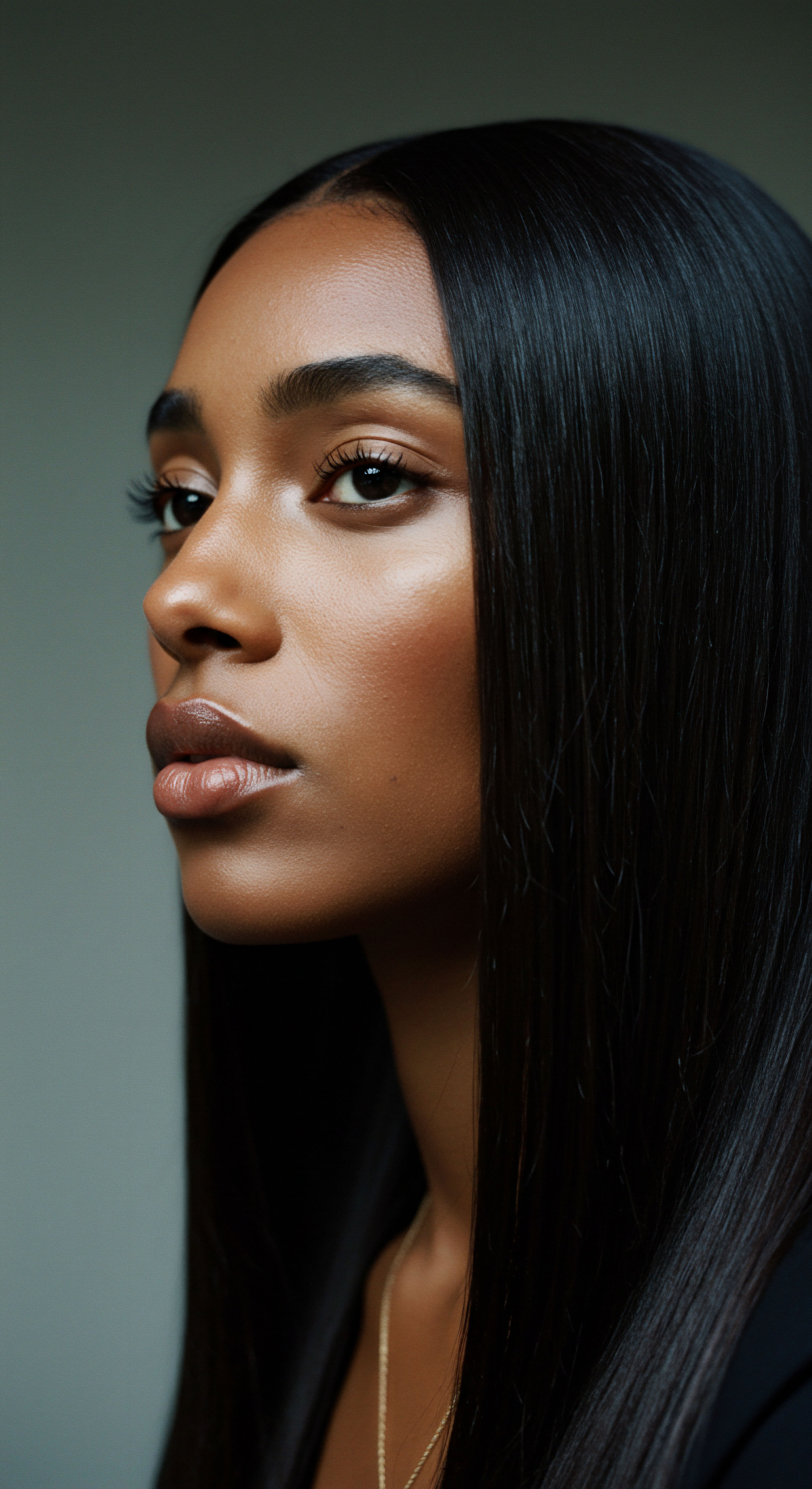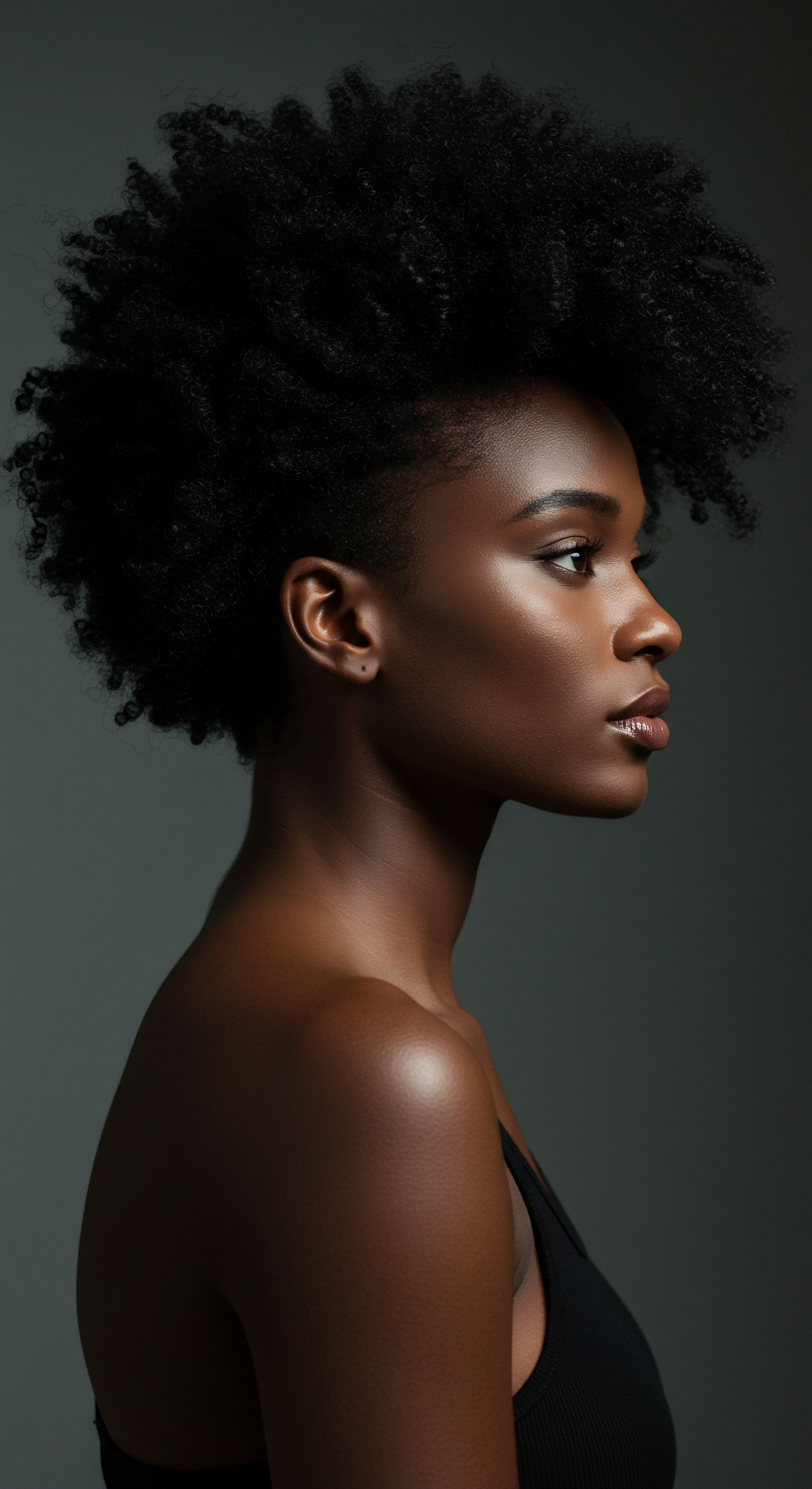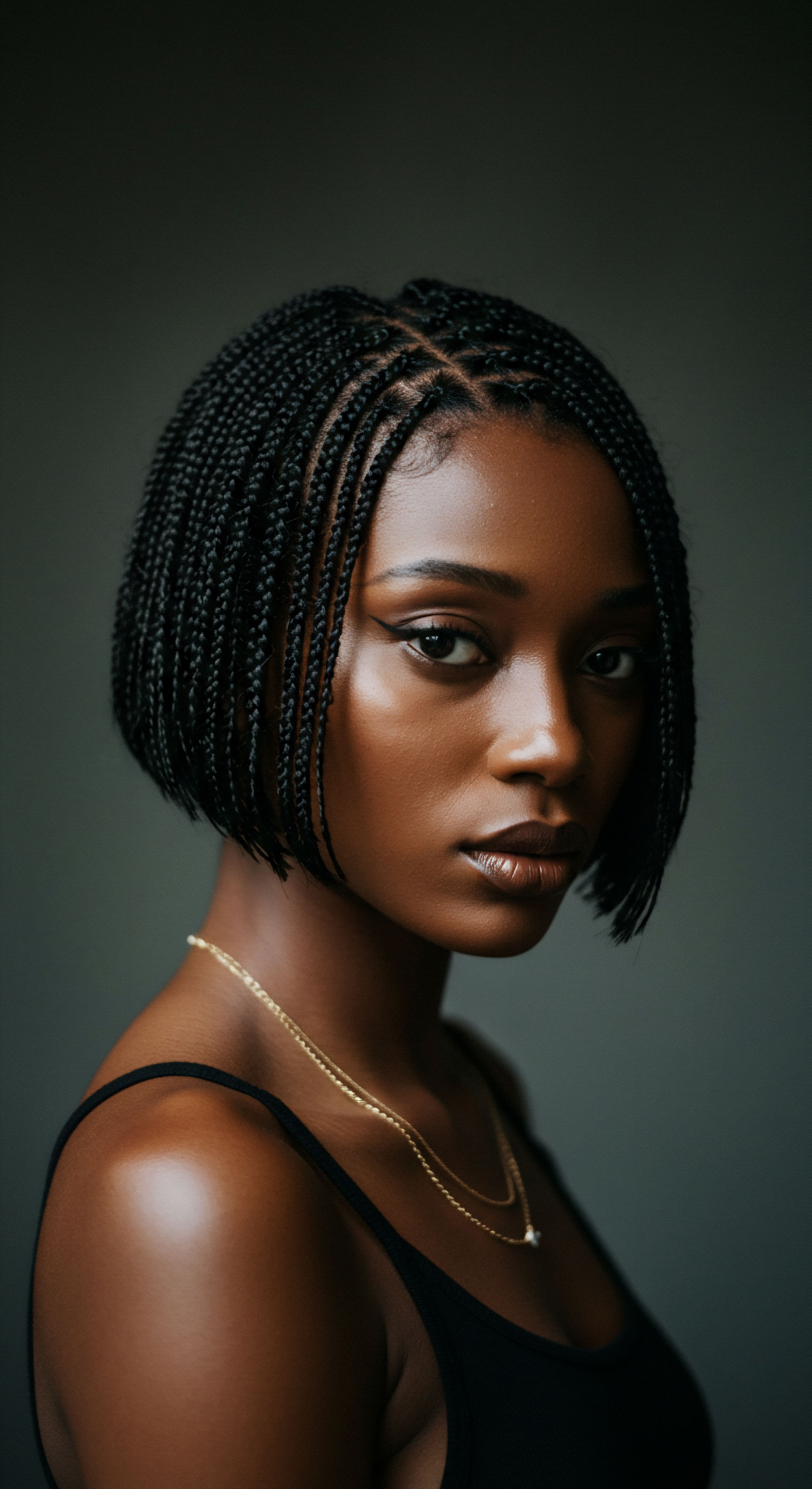
Roots
The whisper of ancient winds often carries tales of human ingenuity, particularly in how our ancestors shielded their precious hair from the elements. Long before the advent of modern hair care, communities across the globe instinctively understood the vulnerability of hair, especially textured strands, to environmental stressors. This awareness, born from observation and necessity, led to the adoption of specific materials for protection. These choices were not arbitrary; they reflected a deep, intuitive understanding of fiber properties and their interaction with hair.
Consider the simple act of wrapping, a practice found universally, which speaks volumes about the timeless human desire to preserve and adorn. It was a silent acknowledgment of hair’s delicate nature, a recognition that a barrier, however humble, could make a profound difference.

The Ancient Canopy Early Protection Methods
Early societies, without the benefit of scientific instruments, learned through lived experience which materials offered a gentle shield. The very first protective fabrics were likely those readily available in their natural environments. Animal hides, softened and prepared, could offer a robust defense against harsh sun, biting winds, and abrasive surfaces. Plant fibers, meticulously processed and woven, provided lighter alternatives.
The choice of material often depended on climate and cultural practices, yet the underlying aim remained constant ❉ to create a protective canopy for the hair. This foundational understanding laid the groundwork for more sophisticated practices that would unfold over centuries.

Beyond Aesthetics Why Hair Protection Mattered
While modern discussions of hair often gravitate towards appearance, historically, hair protection carried deeper significance. It was a matter of survival, hygiene, and social standing. Hair, particularly long or elaborately styled hair, could become tangled, damaged, or infested without proper covering. In agrarian societies, head coverings shielded hair from dust, dirt, and debris during daily labor.
For royalty and spiritual leaders, specific head coverings not only protected but also signified status and reverence. Hieroglyphic evidence from ancient Egypt points to pharaohs covering their hair with wigs or headbands, often made of cloth, which carried specific meaning and significance. The utility extended beyond mere preservation; it was about maintaining health, dignity, and cultural identity.

What Did Early Societies Understand About Hair Vulnerability?
Early societies possessed an implicit understanding of hair’s delicate structure, even without a microscope. They observed that hair exposed to constant friction, harsh sun, or environmental contaminants would become brittle, dry, and prone to breakage. This observation guided their selection of protective materials. They sought out substances that minimized snagging, allowed for some air circulation, and perhaps, helped retain natural oils.
The smoothness of certain fibers, the way they draped without pulling, or their ability to offer a physical shield against external forces were all intuitively grasped qualities. This ancient wisdom, passed down through generations, formed the bedrock of hair care traditions that continue to influence us today.
Ancient wisdom regarding hair protection was rooted in keen observation of environmental stressors and the intuitive selection of naturally available, gentle materials.

Ritual
Stepping from the foundational understanding of hair’s needs, we turn now to the practices that transformed simple materials into profound acts of care. The daily and nightly rituals surrounding hair protection are not merely rote actions; they are quiet conversations between the individual and their heritage, a gentle guidance through the practical wisdom accumulated over generations. This segment delves into the applied aspects of historical hair protection, moving beyond the ‘what’ to the ‘how’ and ‘why’ of specific fabric choices, offering a window into the thoughtful routines that shielded textured hair across time.

The Art of Wrapping Head Coverings as Sanctuary
Head coverings, from simple scarves to elaborate wraps, served as more than just adornment; they were a sanctuary for textured hair. In various African cultures, headwraps, known as ‘Dukus’ in Ghana or ‘Geles’ in Nigeria, have a rich cultural history and served as protective headgear. They were worn to shield hair from dust and dirt during chores, and also during sleep to protect hair. The choice of fabric for these wraps was crucial.
Materials that offered a smooth surface reduced friction, which is particularly significant for textured hair, prone to tangling and breakage when agitated. Headwraps became a shield against environmental aggressors like sun and wind, helping to preserve the hair’s natural moisture and integrity. This protective function, combined with their symbolic meaning, solidified headwraps as an indispensable element of historical hair care.

Nighttime Guardians The Role of Sleepwear
The hours of sleep, while seemingly restful, can be a period of intense friction and moisture loss for hair. Historically, this vulnerability was recognized, leading to the use of specific fabrics for nighttime hair protection. The concept of a smooth surface to reduce friction against hair while sleeping is not a modern discovery. Women would often wrap their hair in soft cloths or wear specially designed caps made from smooth, non-absorbent materials.
This practice aimed to minimize the mechanical stress on hair strands as one shifted during the night, preventing tangles, frizz, and breakage. It was a silent, nightly commitment to preserving hair health, acknowledging that consistent, gentle care yielded lasting benefits.

How Did Specific Textile Properties Shape Protective Practices?
The inherent properties of different textiles dictated their suitability for hair protection. Consider the contrasting qualities of cotton versus silk.
- Cotton ❉ While widely available and breathable, cotton fibers possess a rougher, more absorbent surface. This roughness creates friction, which can snag and pull at delicate hair cuticles, leading to frizz and breakage. Furthermore, cotton’s absorbent nature can draw moisture away from hair, leaving it dry and brittle. Historically, its widespread use was often due to availability and cost rather than superior protective qualities for hair.
- Silk ❉ Revered for its smooth, slippery texture, silk offers significantly less friction against hair strands. This allows hair to glide rather than snag, reducing tangles, frizz, and breakage. Silk is a natural protein fiber, composed of fibroin and sericin, and its tightly woven structure helps hair retain its natural oils and moisture. This makes silk a superior choice for preserving hydration, especially for textured hair which tends to be more prone to dryness.
- Satin ❉ While not a natural fiber itself, satin is a weave that can be made from various materials, including silk, polyester, or nylon. When satin is made from synthetic fibers, it can still offer a smooth surface that reduces friction compared to cotton. However, synthetic satin may not offer the same breathability or moisture-retaining properties as natural silk. Historically, the smoothness of satin weaves, regardless of fiber content, would have been recognized for its gentle interaction with hair.
The careful selection of materials like silk and satin for head coverings and sleepwear reflects a historical understanding of friction and moisture balance in hair care.
| Fabric Type Silk |
| Key Properties Smooth surface, low friction, protein structure, moisture retention, breathable. |
| Impact on Textured Hair Minimizes frizz, reduces breakage, preserves hydration, maintains hair's natural oils. |
| Historical Application Head wraps, scarves, inner linings of caps for nobility and those who could access it. |
| Fabric Type Satin (Silk-based) |
| Key Properties Smooth weave, low friction, similar benefits to pure silk. |
| Impact on Textured Hair Reduces tangles and frizz, gentle on hair surface. |
| Historical Application Similar to silk, often used for its luxurious feel and appearance. |
| Fabric Type Satin (Synthetic-based) |
| Key Properties Smooth weave, reduced friction compared to cotton, less breathable than silk, may not retain moisture as well. |
| Impact on Textured Hair Better than rougher fabrics for friction reduction, but lacks silk's natural benefits. |
| Historical Application More common in later periods with synthetic fiber development, offering a more accessible smooth option. |
| Fabric Type Fine Linen |
| Key Properties Smoothness depends on weave, less absorbent than cotton, breathable. |
| Impact on Textured Hair Could offer some friction reduction if finely woven, but generally less effective than silk. Ancient Egyptians used fine linen for head coverings to protect from the sun. |
| Historical Application Everyday head coverings, veils, wraps in various ancient cultures. |
| Fabric Type Cotton |
| Key Properties Absorbent, rougher fibers, breathable. |
| Impact on Textured Hair High friction leading to tangles, frizz, breakage; absorbs hair's natural moisture. |
| Historical Application Widespread use due to availability, often as outer layers, with inner smooth linings preferred when possible. |

Relay
Having explored the foundational wisdom and practical applications of historical hair protection, we now turn our attention to the intricate dance where scientific understanding converges with cultural legacy. This section delves into the subtle yet profound mechanisms by which certain fabrics safeguarded textured hair, examining the interplay of fiber structure, environmental factors, and the enduring traditions that shaped these choices. We will seek to understand the deeper connections, moving beyond surface-level observations to the underlying scientific principles and cultural narratives that informed protective practices.

The Microscopic Dance Hair Cuticle and Fabric Friction
At the heart of hair protection lies the hair cuticle, the outermost layer composed of overlapping scales. For textured hair, these scales are often naturally more raised, making the strands particularly susceptible to friction. When hair rubs against rough surfaces, these cuticle scales can lift, chip, or even break, leading to frizz, dullness, and eventual breakage. This mechanical damage is a primary concern.
Research consistently demonstrates that materials with a lower coefficient of friction are gentler on hair. A study by TRI Princeton, for example, showed that luxury silk was the smoothest material, significantly reducing friction compared to cotton. The smoothness of silk allows hair to glide across its surface, minimizing the abrasive action that disrupts the cuticle. This physical interaction, understood intuitively by past generations, now finds its scientific validation.

Cultural Significance of Protective Adornment
Beyond the physical protection, head coverings held immense cultural weight, particularly within communities with rich traditions of textured hair care. In many African cultures, headwraps served as powerful symbols of identity, status, and spiritual belief. They were not merely functional items but statements of pride and resilience. During periods of enslavement in the United States, headwraps were sometimes forced upon Black women as a symbol of subservience, yet these women defiantly transformed them into declarations of dignity and resistance, adorning them with feathers and jewels.
This transformation speaks to the profound connection between hair, identity, and the protective coverings chosen. The fabric itself became a canvas for cultural expression, a silent language conveying heritage and strength.

Can Ancient Practices Offer Modern Insights For Hair Health?
The wisdom of historical hair protection, particularly the preference for smooth, non-abrasive fabrics, offers compelling insights for contemporary hair care. The scientific understanding of hair’s vulnerability to friction and moisture loss echoes the practices of our ancestors.
- Reduced Friction ❉ The choice of silk and satin historically for sleeping caps or headwraps directly correlates with modern research on reducing hair breakage. Studies show that the friction from cotton can increase hair breakage by up to 50% compared to smoother fabrics. This reinforces the long-held belief that smooth surfaces are superior for preserving hair integrity.
- Moisture Retention ❉ Textured hair is often prone to dryness due to its structure, which makes it harder for natural oils to travel along the strand. Cotton’s absorbent nature can exacerbate this by drawing moisture away from the hair. Silk, on the other hand, helps preserve natural oils and applied hair care products, allowing hair to stay hydrated. This scientific backing validates the historical preference for silk as a moisture-preserving barrier.
- Temperature Regulation ❉ Wool, while having a rougher surface than silk, historically provided thermal insulation, protecting hair and scalp from extreme temperatures. Its unique fiber structure creates air pockets that trap heat and wick moisture. This property was particularly useful in harsh climates, preventing both excessive drying from cold and overheating.
The historical preference for smooth fabrics like silk finds modern scientific validation in their ability to reduce friction and preserve hair hydration.

A Case Study The Hidden Resilience of African Textiles
Beyond the well-documented benefits of silk, a deeper examination of traditional African textiles reveals a fascinating interplay of fiber properties and cultural adaptation that often goes overlooked in mainstream hair care discussions. While cotton was a prevalent fiber due to its accessibility, certain indigenous weaving techniques and fiber preparations in various African communities might have inadvertently enhanced its protective qualities or mitigated its abrasive nature. For example, some traditional African cotton fabrics were often hand-spun and loosely woven, creating a softer, more yielding surface than industrially produced cotton. Additionally, the practice of oiling or treating the hair with natural butters before wrapping could have created a protective barrier, further reducing friction regardless of the outer fabric.
Consider the broader context of humidity and hair. Textured hair, particularly curly and coily types, is highly susceptible to humidity. High humidity causes hair to absorb excess moisture, leading to swelling of the hair shaft and disruption of the cuticle layer, resulting in frizz and unmanageability. Conversely, low humidity can lead to excessive dryness and breakage.
Traditional head coverings, often made from locally sourced materials, served as a crucial buffer against these environmental fluctuations. While not a direct scientific study on traditional African cotton specifically, a broader examination of hair fiber mechanics highlights that the more porous hair strands are, the more moisture they absorb, leading to rough, lifted hair cuticles. Traditional headwraps, by providing a physical barrier, would have helped moderate the hair’s exposure to rapid changes in atmospheric moisture, thereby reducing hygral fatigue – the repeated swelling and shrinking of hair shafts that contributes to damage and breakage. This subtle, often unarticulated, function of traditional head coverings speaks to a deep, experiential knowledge of hair’s environmental sensitivities.
| Fiber Type Silk |
| Surface Texture Smooth, low scales |
| Moisture Interaction Low absorbency, helps retain hair moisture |
| Friction Coefficient (Relative) Very Low |
| Fiber Type Cotton |
| Surface Texture Rough, convoluted ribbon form |
| Moisture Interaction High absorbency, draws moisture from hair |
| Friction Coefficient (Relative) High |
| Fiber Type Wool |
| Surface Texture Scaly projections, crimped |
| Moisture Interaction High moisture absorption (as vapor), insulates |
| Friction Coefficient (Relative) Medium-High (can cause tangling due to scales) |

Reflection
As we close this exploration, the echoes of historical practices blend with the clarity of modern science, revealing a continuous thread of wisdom concerning textured hair protection. The fabrics chosen by our ancestors were not simply utilitarian; they were expressions of care, cultural identity, and an intuitive grasp of material science. From the deliberate smoothness of silk to the insulating properties of wool, each choice spoke to a deep understanding of hair’s delicate nature and its susceptibility to the world around it.
This journey through time underscores a profound truth ❉ the quest for healthy, resilient hair is an enduring human endeavor, one that finds strength in both ancestral knowledge and contemporary discovery. Our hair, a living crown, continues to whisper stories of the past, reminding us that its preservation is a legacy worth upholding.

References
- Bhushan, B. Guohua, W. & Haddad, P. (2014). Friction Dynamics of Straight, Curly, and Wavy Hair. Journal of Applied Physics, 116(18), 184904.
- El-Messiry, M. Hassan, A. & El-Kady, H. (2017). Electric Static Charge Generated from the Sliding of Head Scarf Textiles against Skin and Hair. Journal of Textile Science and Technology, 3(1), 1-8.
- Henne, T. & Hoppe, U. (1986). Sericin ❉ A New Cosmetic Ingredient. International Journal of Cosmetic Science, 8(2), 79-88.
- Khumalo, N. P. Gumedze, F. & Ngwanya, M. (2000). Hair breakage and hair styling practices ❉ a cross-sectional study of African women in South Africa. International Journal of Dermatology, 39(8), 612-615.
- Schwartz, A. M. & Knowles, D. C. (1963). Frictional Effects in Human Hair. Journal of the Society of Cosmetic Chemists, 14(10), 653-664.
- Shafik, A. (1993). Polyester but not cotton or wool textiles inhibit hair growth. Dermatology, 187(4), 239-242.
- Wortmann, F. J. & Schwan-Jonczyk, A. (2006). Hair ❉ Science and Technology. Cosmetics & Toiletries, 121(7), 49-56.